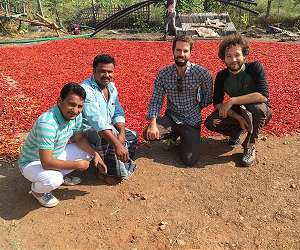On April 18, NASA decided to move forward with plans to complete the deployment of the Lucy spacecraft’s stalled, unlatched solar array. The spacecraft is powered by two large arrays of solar cells that were designed to unfold and latch into place after launch. One of the fan-like arrays opened as planned, but the other stopped just short of completing this operation.
Through a combination of rigorous in-flight solar array characterization and ground testing, Lucy engineers determined the unlatched solar array is nearly fully open, positioned at approximately 345 out of the full 360 degrees, and is producing ample energy for the spacecraft. Nonetheless, the team is concerned about potential damage to the array if the spacecraft conducts a main engine burn in its present configuration.
After launch, the arrays were opened by a small motor that reels in a lanyard attached to both ends of the folded solar array. The team estimates that 20 to 40 inches of this lanyard (out of approximately 290 inches total) remains to be retracted for the open array to latch.
The solar array was designed with both a primary and a backup motor winding to give an added layer of reliability for the mission-critical solar array deployment. Lucy engineers will take advantage of this redundancy by using both motors simultaneously to generate higher torque than was used on the day of launch. Ground tests show that this added torque may be enough to pull the snarled lanyard the remaining distance needed to latch.
The team is now preparing to complete the solar array deployment in two steps. The first step, tentatively scheduled for the week of May 9, is intended to pull in most of the remaining lanyard and verify that flight results are consistent with ground testing. This step will also strengthen the array by bringing it closer to a fully tensioned state. Because this step is designed to be limited in duration, the array is not likely to latch at that point.
If this step goes as planned, the second step will continue the array deployment with the intent to fully latch. Information gleaned from the first part will help fine-tune the second. The second step is currently planned for a month after the initial one, giving engineers enough time to analyze the data seen in the first attempt.
Related Links
Lucy at SwRI
All About Solar Energy at SolarDaily.com
|
We need your help. The SpaceDaily news network continues to grow but revenues have never been harder to maintain. With the rise of Ad Blockers, and Facebook – our traditional revenue sources via quality network advertising continues to decline. And unlike so many other news sites, we don’t have a paywall – with those annoying usernames and passwords. Our news coverage takes time and effort to publish 365 days a year. If you find our news sites informative and useful then please consider becoming a regular supporter or for now make a one off contribution. |
||
|
SpaceDaily Contributor $5 Billed Once credit card or paypal |
SpaceDaily Monthly Supporter $5 Billed Monthly paypal only |
|

![]()
Solar technology and community engagement team up to help low-income farmers in India
Stanford CA (SPX) Apr 19, 2022
Involving people who will directly benefit from technology research is critical to sustainable development, as researchers have experienced by working with chili farmers in India for more than four years.
A team led by Stanford University developed a solar-powered technology to improve the quality and quantity of dried agricultural produce and potentially increase incomes of smallholder farmers in India, which average around $5 per day. Due to better quality, chilies dried by the equipment were so … read more
